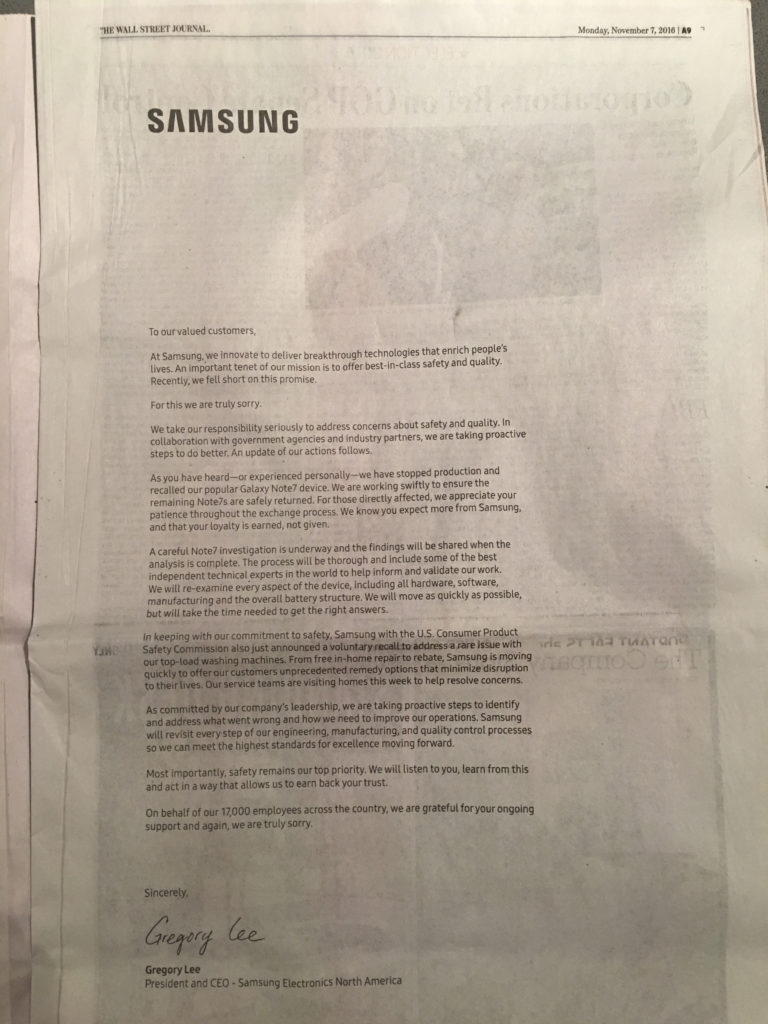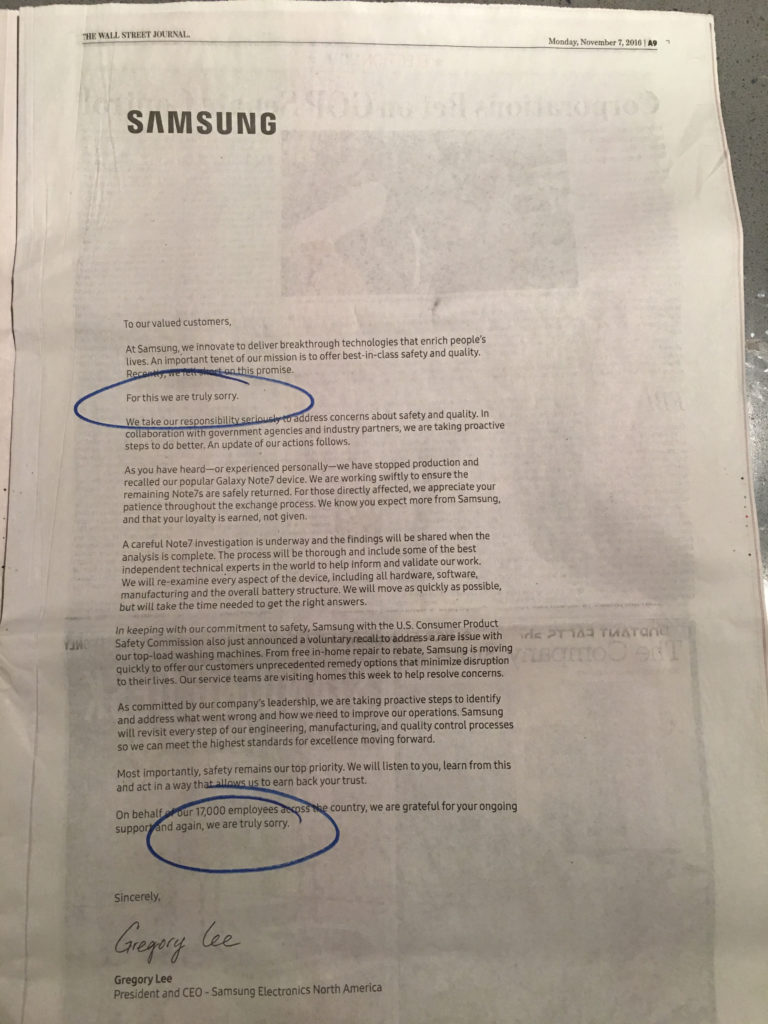12 Nov The Fake Apology vs. the Real Apology … Lessons from Wells Fargo and Samsung
“I’m sorry.”
Clearly these are two of the toughest words for any youngster to learn as they grow-up. (Just ask any parent if you’re not clear on this fact.) And that’s not taking into account any aspect of the sincerity of one’s mea culpa, either.
As someone who has written seriously since the 3rd Grade and who has served as a professional wordsmith for several decades, it feels like I spend an inordinate amount reading, writing and deciphering the nuances of language. Add to that my 30-plus-years as a communications and marketing consultant / executive (including stints immersed in the heart of numerous Crisis Communications kerfuffles), and I suspect it’s not surprising that I’ve been highly intrigued as I’ve watched the recent unfolding of two separate corporate implosions, events that have occurred on a massive scale.
Implosion #1: Fake Accounts Scandal at Wells Fargo
In summary, this past summer, Wells Fargo admitted that for the past several years its internal sales programs led many of its retail employees to create upwards of two million fake customer accounts … all to win ill-gotten bonuses.
The fallout from these revelations led to massive shakeups within the then-largest financial institution in the United States, including
- The firing of over 5,300 employees,
- The soft-pedaled dismissal of Wells Fargo Chairman and CEO, John Stumpf, and
- $185 million in government fines levied against the company.
Oh, yeah, the news about the illegal activities fomented a $25 billion drop in the value of Wells Fargo.
Implosion #2: Exploding Samsung Phone Batteries
With over 480,000 employees worldwide, Samsung is one of the largest and strongest companies in the world, providing products and solutions ranging from heavy machinery to household appliances. And this includes the now ill-fated Galaxy Note7 smartphone.
Announced by Super Bowl commercial in February 2016 and launched several months later in August, the Galaxy Note7 was Samsung’s attempt to trump (and beat-to-the-punch) Apple and its then forthcoming iPhone 7 smartphone. Unfortunately, the lithium-ion battery of Note7 had this terrible tendency to explode (at least some of said batteries did this), with some news reports suggesting that the battery problems were missed because Samsung cut testing corners to allow it to launch the Note7 on schedule and before the aforementioned iPhone 7. As a result, all Note7s have been recalled and the product has been killed-off by Samsung.
Oh, yeah, and Samsung experienced its own $26 billion drop in market cap following the Galaxy Note7 debacle.
Crisis Communications 101
When you first study Crisis Communications (either in school or on the job), you learn that there are several Rules of Thumb that must be followed to ensure the best possible outcome.
- Plan. Ideally, every organization will have the foresight to contemplate what might go wrong and to put in place a Crisis Communications Plan that addresses potential disasters and guidelines on how to deal with such problems.
- Speed. Clearly each Crisis will be different for each organization and potentially within each organization. But when a problem arises, acting swiftly and decisively is often crucial to fixing challenges and minimizing their negative impact, both near- and long-term.
- Truthfulness. Whether a management team is dealing with a purely internal matter or one that is massively public (as in the Wells Fargo and Samsung situations discussed in this Post), it is imperative that management is both forthright and truthful in all communications with its various “publics” … from employees to shareholders and from clients to journalists. Some advisors (either internal or external) may counsel such a path is fraught with risk; conversely, I suggest that obfuscation of any sort, let alone outright lying, contains even greater risks, both organizationally and personally. (Case in point, ever since the Watergate hearings, the questions — “What did you know?” and “When did you know it?” — have been common lines of questioning both in courtrooms and legislative/agency hearings.)
- Apologize. Not every crisis situation deserves or demands a corporate Mea Culpa. But in those instances where internal actions or inactions lead to a level of culpability by the organization and/or any of its employees, officers or board members, then it is incumbent on those “In Charge” to apologize for what happened.
- Fix It. Last of all, every crisis situation demands that steps be taken to ensure that the problem is not repeated. And if damage of any type has occurred, clearly there must be restitution made to any individuals or organizations harmed in the process.
A Non-Apology vs. A Real Apology
It is not my intent to dive into a deep analysis within this Post as to all of the steps taken (or passed over) by either Wells Fargo or Samsung as they have dealt, respectively, with these two massive crisis situations … both of which were clearly caused by the companies themselves.
Obviously, I was not privy to all of the relevant meetings and discussions inside these organizations when critical decisions were or were not made that led to the respective crises. Similarly, I was not a so-called fly-on-the-wall when Crisis Communications decisions were made and actions implemented to stop the bleeding at either firm.
However, this past week I came across two very contrasting Crisis Communications actions by the two firms. Specifically, both Wells Fargo and Samsung have now published full-page ads in the Wall Street Journal addressing their respective crises … advertisements that have given me pause.
Specifically, here’s the ad from Wells Fargo. {Apologies up front for the less-than-perfect quality of the images.}
Conversely, here’s the full-page ad from Samsung.
QUESTION: Did you catch the two main differences between the ads?
Sure, Wells Fargo included a photo in its ad and Samsung did not. It’s also clear that Samsung’s ad is in the form of a letter from the President and CEO of Samsung Electronics North America, while the Wells Fargo advertisement is truly an ad (one with a Web address and toll-free number, for sure, but an ad nonetheless). And to be clear, there is nothing wrong, per se, with such an ad from Wells Fargo.
But these are not the two main differences I’m asking about.
Here, let me show you another image of the Samsung ad, this one with two items highlighted on the ad.
Here are the two differences I found between Wells Fargo’s ad and the ad from Samsung.
- Samsung Apologized, while Wells Fargo did NOT.
- Samsung’s Apology was extended by its U.S. President & CEO.
From what is known at this time, both companies (and their executives) were directly or indirectly culpable for the crises thrust upon their clients by decisions made inside their firms.
As noted above, such decisions led to millions of fake accounts created for clients without their knowledge (in the case of Wells Fargo) and to exploding smartphones (in the case of Samsung). And both firms have suffered serious financial repercussions as a result, reverberations that were quite predictable.
However, although I am currently an Apple adherent and an iPhone user (something I expect to be for sometime), the next time I go looking for a new household appliance or another product/solution manufactured by Samsung, I will give their offerings deep and serious consideration. And I will do so, in part, because Gregory Lee took personal responsibility for the Note7 disaster and issued a public apology.
Conversely, there is no such public apology or no public admission of culpability by Wells Fargo or any of its executives in the ad shared above. And as far as I can find, Wells Fargo has not issued any type of public apology in any of its public communications about its crisis.
My Conclusion
Years ago, I held several personal and professional bank accounts at Wells Fargo. But over time, the professional demeanors and personalities of the local managers of the branches where I banked changed. Why? To be honest, I do not know.
But given what I have seen/learned since these Wells Fargo misdeeds came to light, I wonder.
I do know this, however. I have no intent of opening a Wells Fargo account any time soon. None whatsoever.
# # #
A marketing and communications expert, David L. Politis recently published his first book — 66 RULES for Publicity Success: Boost Your Company’s Value for Pennies on the Dollar. David currently helps clients address their crises, publicity and marketing challenges through The David Politis Company.






The David Politis Company | No Thanks, I Don’t Want the Head PR Job at United Airlines
Posted at 11:04h, 12 April[…] already written about Wells Fargo’s communications debacles in mishandling revelations that its employees created fake customer accounts to reap bonuses, so I […]